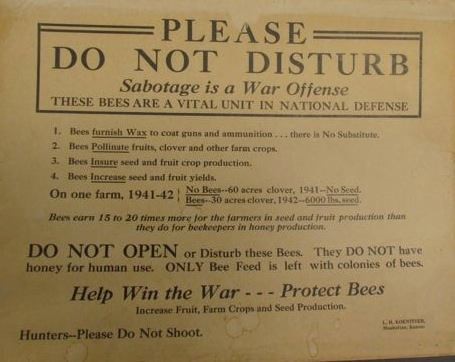Despite the hype, there’s still no bee-pocalypse. Two weeks ago, the U.S. Department Agriculture released its latest count of commercial honeybee hives, and although the figure dipped 2.9 percent from the 20-year record-high set in 2014, the overall count of 2.7 million hives in 2015 remains strong. You wouldn’t know it from the news coverage.
One Michigan television station recently led with the headline: “Numbers of managed honey bee colonies plummeting.” It explained: “According to the USDA the total number of managed honey bee colonies has decreased by 2.5 million since the 1940s.”[1] This is misleading for a number of reasons.
First of all, there’s no plummeting of bee numbers. A full-strength hive can easily hold 30,000 or 40,000, which means there are around 80 billion honeybees in the United States—ten for every human on the planet. The United Nations counts about 80 million hives worldwide, meaning the global total of honeybees is a 13-digit number of a magnitude more commonly used to measure government debt.
And secondly, honeybees are just one of over 20,000 known bee species, so it’s safe to conclude that the managed honeybee shortage just isn’t a real thing, especially since it has become an amateur fad and that has led to many deaths from mismanagement.
Activists want everyone to think otherwise for a simple reason: Dead bees are great for fundraising. Depending on the time of year, a worker bee might only live five or six weeks before keeling over. Even so, sometimes activists can’t find any bee corpses to mourn over and have been forced to resort to dressing up in bee costumes to stage a “die in.”[2] The impression that they mean to convey is that big, bad pesticides are wiping bees out to the edge of extinction. The activists single out neonicotinoids, the most popular, most modern and most effective insecticide as the cause of the supposed decline.
It’s a nice story, but it doesn’t hold up to the slightest scrutiny. Neonicotinoids, or neonics for short, came on the market in the mid-1990s, back when U.S. honeybee colony numbers hovered in the 2.6 million range. There are more colonies today, even with the latest dip, than there were in 1995. In other words, bees aren’t dying off in the wake of modern pesticides, they’re growing.
This is where the bait-and-switch comes into play. It’s absolutely true that there were more managed honeybees in the 1940s. Bees were part of the war effort, producing wax used to coat guns and ammunition. So when the war ended, subsidies were introduced to prop up the beekeeping industry.[3] Thanks to Uncle Sam’s support, bee populations peaked at around 5.5 million in the 1950s, then gradually dropped to around 2.6 million in the mid-1990s.None of that drop can be attributed to neonics, because they only came on the market in the mid-1990s, and didn’t exist in that five decade period of decline.
 Now, the national bee
numbers did decline at bit around the year 2005 -- to 2.4 million. That was the
year in which colony collapse disorder (CCD) struck. The term that describes the
unexplained death or disappearance of a hive’s adult bees.
Now, the national bee
numbers did decline at bit around the year 2005 -- to 2.4 million. That was the
year in which colony collapse disorder (CCD) struck. The term that describes the
unexplained death or disappearance of a hive’s adult bees.
As USDA puts it, “No
scientific cause for CCD has been proven.”[4] Activists see the lack of a clear cause as a wide-open opportunity to come up
with their own explanation. So they blame neonics.
Calmer minds reflecting on the evidence conclude that the CCD phenomenon existed long before the scientists who invented neonics were even born. Indeed, the November 19, 1868 edition of the Louisville Democrat described CCD-like symptoms with the headline: “Extraordinary exodus of honey bees—They abandon their winter stores and disappear.”[5] Throughout history, CCD has come and gone, and right now, it has gone. There hasn’t been a case in four to five years.[6]
Pesticide seed treatments didn’t exist in the middle of the 19th century, but disease did ravage hives, just as it does now.[7] The USDA has already identified the primary suspect that has been spreading disease: “The parasitic mite Varroa destructor remains the single most detrimental pest of honey bees.”[8] This blood-sucking creature latches onto young bees, injecting over a dozen types of debilitating viruses that can devastate entire hives.
But who’s going to write a donation to an activist group for “mite control”? Nobody sees the value in standing up to “Big Insect” when these well-funded groups can pretend to be little guys going up against Big Agriculture and its insistence on using technology to grow more food. Blaming pesticides and “saving bees” that don’t actually need to be saved might not be accurate, but it’s highly profitable.
The disappearing bees myth is a political disease that can only be eradicated with the truth. The real story here is that there’s a twenty-year trend in honeybee hive numbers, and those numbers remain strong at about 2.7 million.
[2] http://www.science20.com/news_articles/bees_activists_remain_silent_while_this_pollinator_killer_decimates_millions-156704
[5] As reprinted in the New York Times.
http://query.nytimes.com/gst/abstract.html?res=9F07E0DE1030EE34BC4A51DFB7678383679FDE
[6] http://www.growingproduce.com/production/a-combination-of-culprits-are-related-to-the-decline-in-bee-populations/
[7] Cf. American Bee Journal, 1868. https://books.google.com/books?id=zcW4AAAAIAAJ&pg=RA1-PA138&lpg=RA1-PA138&dq=%E2%80%9CExtraordinary+exodus+of+honey+bees%E2%80%94They+abandon+their+winter+stores+and+disappear.%E2%80%9D&source=bl&ots=hlf0DVZxjd&sig=T3MlkMB9nFqkpx-CfN-lypiEUZ0&hl=en&sa=X&ved=0ahUKEwiRs7f08tnLAhVCbz4KHa5zA0gQ6AEIJTAC#v=onepage&q=%E2%80%9CExtraordinary%20exodus%20of%20honey%20bees%E2%80%94They%20abandon%20their%20winter%20stores%20and%20disappear.%E2%80%9D&f=false




Comments